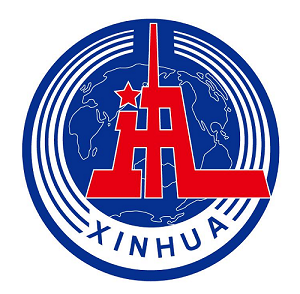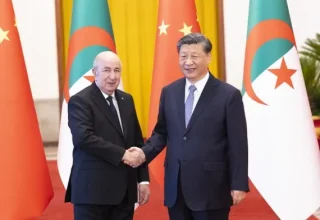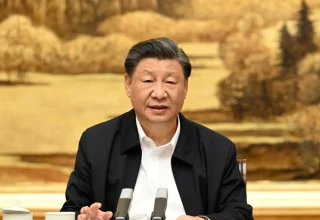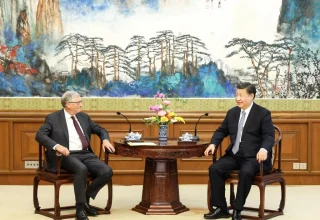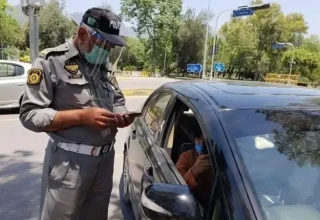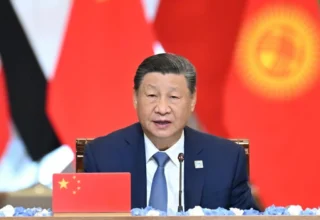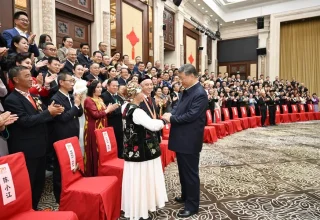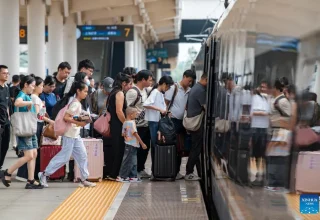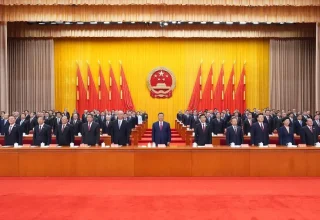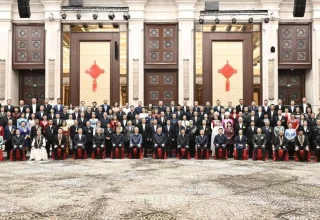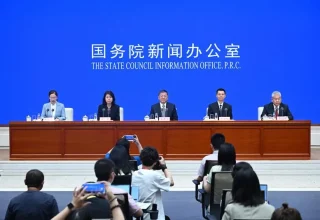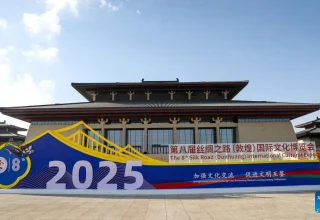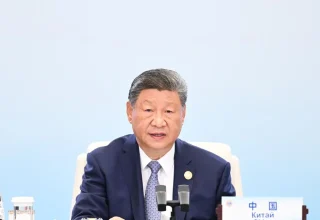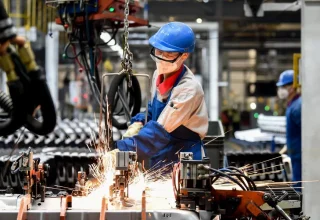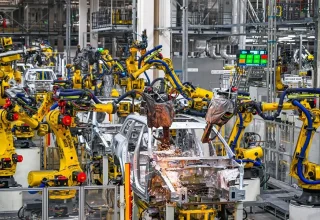
BEIJING: People across the country marked the 76th anniversary of the People’s Republic of China on Wednesday with travel, shopping and family reunions as an eight-day holiday began.
Hundreds of millions are on the move, foreign tourist arrivals are rising, and smart factories are running at full capacity to fill surging global orders.
Beyond the bustle of activity, another task is underway: policymakers are drafting the country’s next phase of development.
Under President Xi Jinping’s leadership, China is formulating its next five-year plan. In three weeks, the Communist Party of China (CPC) leadership will convene a closely-watched plenum to review its proposals for the plan.
The 15th Five-Year Plan (2026-2030) for National Economic and Social Development is the latest in a series of blueprints that, since the 1950s, have guided the country’s rise from an impoverished, agrarian nation to the world’s second-largest economy.
At the National Day reception on Tuesday, Xi, who is also general secretary of the CPC Central Committee and chairman of the Central Military Commission, once again rallied efforts for national rejuvenation, which he described as “a cause without precedent.”
“From the brink of national peril to the path of great rejuvenation, the Chinese nation has pressed ahead through hardship and struggle, yet also with high spirits and resounding triumphs,” Xi said.
HISTORICAL WEIGHT
The latest five-year plan carries unusual weight, as only 10 years remain before 2035 — the milestone year by which China aims to “basically achieve socialist modernization.”
This marks the first goal in Xi’s two-step blueprint for building China into a great modern socialist country in all respects by mid-century, or the centenary of New China.
A month earlier, China held a massive military parade in Tian’anmen Square marking the 80th anniversary of the victory in the Chinese People’s War of Resistance Against Japanese Aggression and the World Anti-Fascist War.
Xi inspected the troops from an open-top Hongqi vehicle, a homegrown brand launched in 1958. Its creation was a hallmark achievement of China’s first Five-Year Plan (1953-1957), which laid the industrial foundations for the newly established republic.
This sight of the vehicle on such a grand occasion underscored the link between China’s early industrial beginnings and its ongoing modernization ambitions. “From the first plan to the 14th, one constant theme has been building China into a modern socialist country,” said Xi.
Seven decades on, the contrast could not be starker. China now manufactures more than 200 types of major industrial products in the world’s largest volumes. By the end of the current 14th Five-Year Plan in 2025, China’s GDP is expected to reach 140 trillion yuan (about 19.7 trillion U.S. dollars).
Between 2021 and 2025, consumption has contributed around 60 percent of China’s annual economic growth. Throughout the period, China has remained the world’s second-largest consumer market, with retail sales rising to about 80 percent of U.S. levels. Its online retail market has been the world’s largest for 12 straight years, while auto sales have topped the global charts for 16 years in a row.
Observers said the 15th Five-Year Plan is seen as another mobilization and overall deployment to build on momentum and advance Chinese modernization.
In his Tuesday address, Xi called for the sound design and implementation of the upcoming plan’s targets and measures to ensure decisive progress toward China’s goal of basically achieving socialist modernization.
Brazilian scholar Maria Luiza Falcao Silva sees a lesson for the wider world. “While much of the West grappled with cycles of crisis — political gridlock, trade wars, populism — China pressed ahead with a long-term national plan,” she said. “The Chinese model is shaping the 21st century.”
INNOVATION, HIGH-QUALITY DEVELOPMENT
Prior to the October plenum, Xi has led a series of meetings and inspections this year with an eye to the five-year plan.
He has stressed that innovation is central to the country’s high-quality development. Early in February, Xi convened a meeting on the private sector. While reaffirming support for the sector, Xi encouraged entrepreneurs to boost innovation and play a larger role in scientific and technological progress.
A hallmark of his domestic tours this year has been his visits to legacy factories across the country. The president’s message was clear: traditional industries “must not be abandoned” but upgraded through innovation.
In the city of Luoyang in Henan Province, Xi inspected a bearing manufacturer with its roots tracing back to the first five-year plan. Over the past decade, the company has moved from low-end to high-end production, and by 2024, advanced bearings accounted for 70 percent of its output, supplying critical sectors such as aerospace and wind power.
“Modern manufacturing cannot thrive without technological empowerment. We must strengthen research into critical technologies and pursue a path of independent innovation,” Xi said.
Xi also underscored the need to plan for future industries.
This focus featured prominently at an April symposium in Shanghai to solicit suggestions for the 15th Five-Year Plan, where Xi stressed the strategic importance of fostering new quality productive forces.
The choice of Shanghai as the venue of the symposium was deliberate — the city is a national hub of AI innovation. A day before the event, Xi inspected a large-model AI incubator in the city. Earlier that month, Xi also chaired a CPC leadership group study session on AI development and regulation, calling for AI-driven technological innovation, industrial upgrading, and application.
Xi’s foresight on AI stretches back at least to October 2018, when, during a leadership group study session, he invoked the “lead goose” effect to stress that AI is a strategic technology spearheading this new wave of scientific and industrial transformation.
Building on this strategic emphasis, China’s open-source AI models — such as DeepSeek, Kimi, and Qwen — are already powering supply chains both domestically and internationally. A Stanford University report earlier this year has shown that China is closing the gap with the United States in the development of cutting-edge AI models.
Innovation, a consistent priority in both the 13th and 14th Five-Year Plans, is now bearing tangible fruits: China ranks 11th in the Global Innovation Index, leads the world in invention patent applications, and has achieved breakthroughs in basic research and high-tech manufacturing.
This week, a CPC leadership meeting, which Xi chaired, called for China’s 2026-2030 development to be guided by a philosophy that focuses on innovation, coordination, green development, openness and shared benefits. It underlined the need to foster new quality productive forces in light of local conditions, and to drive sustained, healthy economic growth and comprehensive social progress.
IMPACT FAR BEYOND BORDERS
While stressing the importance of “managing China’s own affairs well” amid a complex external environment, Xi has also championed China’s active role and responsibility as a major country in a turbulent world.
In September, following his earlier global initiatives on development, security, and civilization, Xi unveiled a new Global Governance Initiative (GGI) at the Shanghai Cooperation Organization summit, calling for broader efforts to forge a more just and equitable system of global governance.
Philemon Yang, president of the 79th session of the United Nations General Assembly, noted that the GGI further demonstrates China’s commitment to an international system with the UN at its core.
“China’s contributions have been impressive,” said Yang, noting the country’s unwavering support for the UN, its advocacy for dialogue and peace, and its dedication to the Global South.
Last week, in his video address at the UN Climate Summit held in New York, Xi announced a package of climate goals for 2035, including an absolute emissions reduction target — a move widely seen as further evidence of China’s commitment to global climate action.
Amid challenges ranging from climate change and energy and food crises to sluggish economic growth, countries around the world increasingly share a common future. In response, China has actively supported fellow developing nations through funding, training, and renewable energy projects.
Reaffirming China’s commitment to peace, development, cooperation, and mutual benefit, Xi has pledged to create new opportunities for the world with its own development.
China is the “world’s factory,” with the most complete industrial chain. With 1.4 billion people — including the world’s largest middle-income group — it is also a vast consumer market. Both as a producer and a consumer, China is deeply integrated with the global economy.
In trade alone, China is a major trading partner for over 150 countries and regions, and has signed 23 free trade agreements with 30 nations and regions. In 2024, trade with Belt and Road partners made up more than half of China’s total, while the country’s services trade exceeded 1 trillion U.S. dollars for the first time, placing the country second worldwide.
Analysts say Xi’s concept of “a new development pattern,” which is focused on the domestic economy while featuring positive interplay between domestic and international economic flows, is likely to gain further traction in the 15th Five-Year Plan. China’s strengths in AI, advanced manufacturing and new energy are emerging as new drivers of global trade and investment.
During the holiday rush, smart factories in Yiwu — the trading hub dubbed the “world’s supermarket” — are running at full capacity to fill orders for the 2026 FIFA World Cup.
Wen Congjian, a Yiwu-based football jersey designer and exporter, is hoping for another revenue surge like the last World Cup. “The shifts in Yiwu’s market always mirror the pulse of the world,” he said.
Amid rapidly evolving global challenges, China will continue to uphold true multilateralism and work with all nations to build a community with a shared future for humanity, Xi said at Tuesday’s reception.

